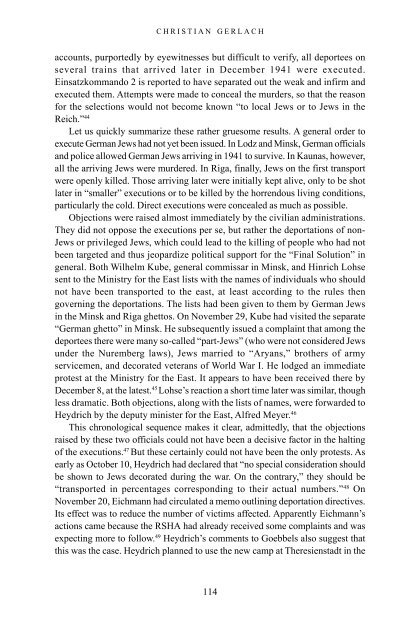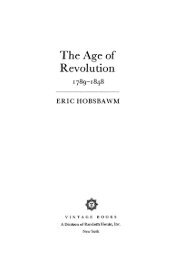The_Holokaust_-_origins,_implementation,_aftermath
The_Holokaust_-_origins,_implementation,_aftermath
The_Holokaust_-_origins,_implementation,_aftermath
Create successful ePaper yourself
Turn your PDF publications into a flip-book with our unique Google optimized e-Paper software.
CHRISTIAN GERLACH<br />
accounts, purportedly by eyewitnesses but difficult to verify, all deportees on<br />
several trains that arrived later in December 1941 were executed.<br />
Einsatzkommando 2 is reported to have separated out the weak and infirm and<br />
executed them. Attempts were made to conceal the murders, so that the reason<br />
for the selections would not become known “to local Jews or to Jews in the<br />
Reich.” 44<br />
Let us quickly summarize these rather gruesome results. A general order to<br />
execute German Jews had not yet been issued. In Lodz and Minsk, German officials<br />
and police allowed German Jews arriving in 1941 to survive. In Kaunas, however,<br />
all the arriving Jews were murdered. In Riga, finally, Jews on the first transport<br />
were openly killed. Those arriving later were initially kept alive, only to be shot<br />
later in “smaller” executions or to be killed by the horrendous living conditions,<br />
particularly the cold. Direct executions were concealed as much as possible.<br />
Objections were raised almost immediately by the civilian administrations.<br />
<strong>The</strong>y did not oppose the executions per se, but rather the deportations of non-<br />
Jews or privileged Jews, which could lead to the killing of people who had not<br />
been targeted and thus jeopardize political support for the “Final Solution” in<br />
general. Both Wilhelm Kube, general commissar in Minsk, and Hinrich Lohse<br />
sent to the Ministry for the East lists with the names of individuals who should<br />
not have been transported to the east, at least according to the rules then<br />
governing the deportations. <strong>The</strong> lists had been given to them by German Jews<br />
in the Minsk and Riga ghettos. On November 29, Kube had visited the separate<br />
“German ghetto” in Minsk. He subsequently issued a complaint that among the<br />
deportees there were many so-called “part-Jews” (who were not considered Jews<br />
under the Nuremberg laws), Jews married to “Aryans,” brothers of army<br />
servicemen, and decorated veterans of World War I. He lodged an immediate<br />
protest at the Ministry for the East. It appears to have been received there by<br />
December 8, at the latest. 45 Lohse’s reaction a short time later was similar, though<br />
less dramatic. Both objections, along with the lists of names, were forwarded to<br />
Heydrich by the deputy minister for the East, Alfred Meyer. 46<br />
This chronological sequence makes it clear, admittedly, that the objections<br />
raised by these two officials could not have been a decisive factor in the halting<br />
of the executions. 47 But these certainly could not have been the only protests. As<br />
early as October 10, Heydrich had declared that “no special consideration should<br />
be shown to Jews decorated during the war. On the contrary,” they should be<br />
“transported in percentages corresponding to their actual numbers.” 48 On<br />
November 20, Eichmann had circulated a memo outlining deportation directives.<br />
Its effect was to reduce the number of victims affected. Apparently Eichmann’s<br />
actions came because the RSHA had already received some complaints and was<br />
expecting more to follow. 49 Heydrich’s comments to Goebbels also suggest that<br />
this was the case. Heydrich planned to use the new camp at <strong>The</strong>resienstadt in the<br />
114



